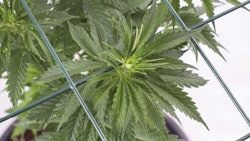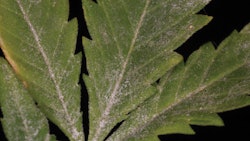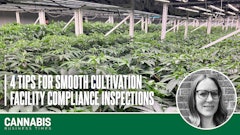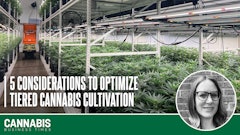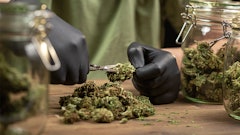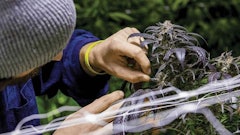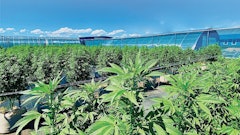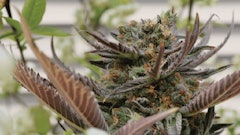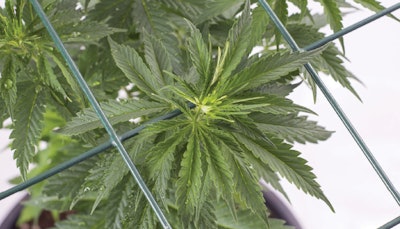
Canopy shape has a significant impact on your company’s bottom line, and that’s seen in the many different canopy shapes cultivators are trying out. No clear consensus has emerged on which approach is best, and that is not surprising for a young industry. These shapes are being created by growers using the familiar techniques of pruning, pinching, trellising and super cropping. Add light, nutrients, hormones and plant spacing to your shaping toolkit, and you can deliver the lowest-cost canopy management program for any growing situation. Here, we review a handful of canopy-shaping techniques and how they can impact your cannabis harvest’s bottom line.
Abstinence
It’s always easiest to do nothing. Many strains grow into bush-like forms with no effort on the grower’s part. So if a grower selects only such strains, they can duck a significant amount of labor. Sativa-dominant strains, on the other hand, often have tall and skinny phenotypes. Even they can be transformed into bushier shapes with the right handling, but the grower must decide if it is cheaper to coerce those plants into a higher-yielding shape or just plant more of them. The answer to that and other shaping questions comes from assessing the cost of producing a given plant size and shape against the additional yield attributable to the shaping.
Short, Tall, Skinny, Fat and Flexible
After doing nothing, the next easiest/cheapest shaping tool is nutrient and light manipulation with which growers can speed up or slow down plant growth at will. While shaping actions determine the basic plant structure, nutrients and light determine size. Combine the two to get the shape you want.
The home-grown plant in the picture on pg. 91 was grown on half the nitrogen most veg formulas contain. The extremely short internodes demonstrate how much growth rates can be controlled this way. This 3-foot plant produced ¾ of a pound of finished product with flowering nutrients, so it is clear that by raising your elbow a little more or less as you pour nutrients into the tank, you can get the plant to do what you want.
Nutrients can also help the extreme shapers out there who use trellising or super cropping. Using more ammoniacal nitrogen (NH4) over nitrate nitrogen (NO3) produces supple branches that can be more easily manipulated. This is a little harder than it sounds since most cannabis nutrients contain only small amounts of NH4 and offer no way to alter that. Nutrient salt users can easily add ammonium sulfate or ammonium nitrate to get the desired suppleness.
Hormones
Pinching off growing points manipulates hormone levels, a process to which all plants are remarkably responsive. Growing points produce auxins, whose presence at certain levels suppresses side branch growth. Reduce or eliminate the auxin levels with a pinch, and that suppression signal is lost resulting in increased side branch growth.
Caged vs. Free Range
Shaping decisions have historically been based on understanding how much more yield is gained from a proposed action. That additional yield will be dependent solely on how efficiently a plant shape intercepts light. (For more, see our column “The Key to Maximum Yield,” in CBT’s January 2017 issue: bit.ly/maximizing-yield.) Growers need to look long and hard at the light-gathering character of any trellis scheme before committing to it.
Yield is not the only reason for trellising. Growers in some states now must comply with total canopy area restrictions, and trellises offer a solution. The cost of this compliance solution is the labor of tying plants to the trellis.
For example, think about a plant with just eight main branches that will be tied along trellis wires as they grow. Assuming each branch needs three ties, 24 ties are required. At 20 seconds per tie-down, including all overhead, this amounts to 8 minutes per plant. Two thousand plants require the equivalent to 6.6 40-hour work weeks and 5,000 plants require 16.6 40-hour work weeks. As prices drop in the market, such costs will draw increasing focus, and the pros and cons of trellising will get a second look.
The alternative to binding plants is freeing them. Free-standing plants require little shaping and don’t have trellising costs. That is a big plus, assuming yield is the same. Canopy area can be easily measured, and compliance should be a proactive activity designed to ensure the operation remains legal.
Spaced Out
The Drug Enforcement Agency (DEA) in 1992 released a study, “Cannabis Yields,” showing that plants given twice the space to grow produced as much as three times the yield of more densely planted crops. The DEA did this study to help field agents quickly assess the amount of cannabis in an illegal operation. Twenty-five years on, the study still offers growers valuable insight into plant growth and a tool for their shaping toolkit.
Apply Yourself
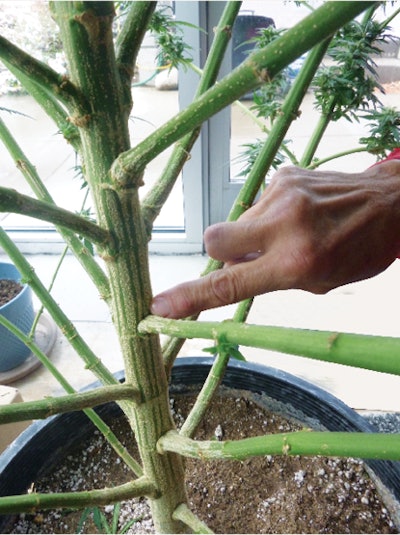
Armed with a now-complete set of shaping tools, all that remains is to apply them appropriately. All cannabis strains produce a natural structure of a single main stem with side branches. Pinching the growing point on that central main stem leader stops vertical growth of the main stem and redirects growth to side branches. Pinch the leader after six to 10 branches have formed, and you will get a multi-stemmed plant that reminds you of a flared flower vase holding a big bouquet of flowers. Combine that structural modification with low nutrients to produce a short, stocky plant with a wide canopy that can hold prodigious flower loads. Do this with many plants to get a sea of green canopy that doesn’t require trellis netting. Labor savings, anyone?
Knowing whether your plants are ahead or behind is key to consistent canopy management. You get this information by measuring plant height and canopy girth over several crop cycles. The information allows you to plot out growth curves over time. Compare the current plants against those curves, and you can see where the plants are versus where they should be. If the plants are right at the height and width on the growth curve, the Growth Progress Index (GPI) is 1.0. If smaller, the GPI is less than 1.0, and if larger, the GPI is greater than 1.0.
Knowing where your plants should be, you can make active growing decisions to keep them on target. If veg plants are smaller than they should be at some point, a nutrient boost and increased light will catch them up. If plants are getting too big during transition, keep them small by reducing nutrient concentrations/frequency and lower light levels during transition.
Super-cropping (see “5 More Tips for Increasing Yields”) is a way to get more flower sites exposed to light. This seems to be a technique unique to cannabis cultivation, suggesting that it arose out of an underground grower’s need to be able to deal with overgrown plants rather than a strategic approach; however, it is standard procedure for more than a few cultivators. Overgrowing plants is another common strategy where plants are allowed to get big and then are cut back to get a denser outer canopy with more flower sites.
There is nothing functionally wrong with these techniques, but additional veg time (up to twice as long) can increase costs and veg space requirements dramatically. We suggest the shaping time and energy can be reduced by a growing plan to get plants directly to their final size with no over-growth using the control techniques discussed here. In this world of the incredible shrinking profit margin, we expect labor-intensive practices to eventually disappear from large-scale cannabis production.
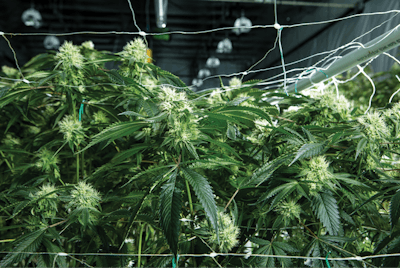
Use Caution
Growers do need to be aware that pinching and pruning at the wrong time can reduce yields. Pruning plants in flower can produce conflicting hormonal signals that can slow growth; contain all pruning and pinching to the veg room, and then use only nutrients and light during transition. Growers using ultra-short veg periods will not have time to do much, if any shaping. And on the cost side, that’s a plus.
Being the free spirits that plants are, from time to time they will send out branches that don’t grow the way you want them to. Branches may grow inward or just too close to other branches. These branches should be removed to keep the canopy open to the airflow that is so important to disease prevention.
Extreme shaping using spreaders, weights and other bonsai-like techniques is no longer commonly seen with production plants due to the labor involved, but the practice lives on in mother plants, which are often grown with multiple main stems. The ability to spread those main stems produces a more productive mother plant.
Canopy management is a game of shape and size, and until one shape is shown to be superior to others, growers will continue to experiment with shaping. What you decide to do to your plants will determine whether you spend a little or a lot on your canopy. For cultivators who spend a lot, the business question is, what are you getting in return?









